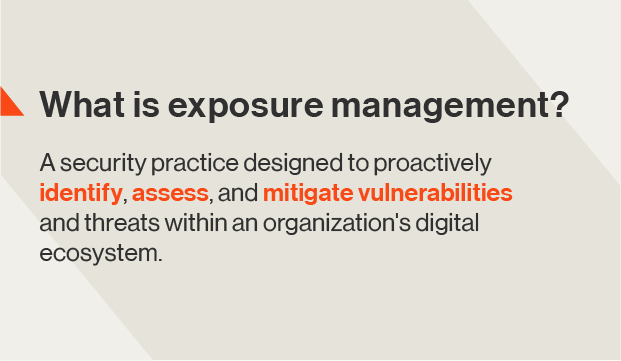Exposure Management
What is cyber exposure?
Cyber exposure is the risk associated with all the vulnerabilities and threats to networks, data, applications, and systems in an organization’s IT environment.
What is exposure management?
Cyber exposure management is a security practice designed to proactively identify, assess, and mitigate vulnerabilities and threats within an organization's digital ecosystem. By identifying cyber exposure, organizations can calculate the level of risk associated with each exposure, evaluate the effectiveness of security controls intended to mitigate each type of risk, and prioritize the steps required to improve security programs and remediate vulnerabilities.

Strengthen security posture with effective exposure management
More organizations today are realizing that cyber risk is business risk, prompting boards of directors to ask hard questions around exposure management. For CISOs and risk leaders, it’s a time of enormous change—but also a time of significant opportunity. Boards are looking to their CISOs to not only protect the organization from risk, but to lead the business as it navigates waves of disruption from expanding infrastructure, changing work models, and sophisticated cyber threats.
Given these expectations, CISOs need powerful solutions to manage growing cyber risk and uncertainty. The right solutions will uncover blind spots of exposure and quantify the impact of that exposure in business terms. A cyber risk management solution must measure efforts to manage risk, revealing what the organization is doing right and where more investment is needed to address areas of disproportionate risk.
As the global leader and category creator in the cybersecurity ratings industry, Bitsight now delivers solutions that empower CISOs and risk professionals to more effectively and holistically manage cyber risk and improve exposure management. With Bitsight, CISOs can demonstrate where the organization is exposed, what the current and potential financial risks are to the organization, and how risk management and security programs are performing.
How to improve exposure management
Your CISOs and risk leaders can enhance exposure management by focusing on four key initiatives.
Prioritize vulnerability management
Security vulnerabilities in software, hardware, and devices are constantly increasing. The number of new disclosed cyber vulnerabilities jumped 25 percent in 2022, and the number of “Known Exploited Vulnerabilities” nearly doubled from 2021 to 2022. To address vulnerabilities in your IT environment and your third-party ecosystem, your risk teams need tools to assess the level of potential exposure and prioritize the most dangerous vulnerabilities for remediation.
Visualize the attack surface
Identifying all the components of your attack surface grows more difficult as your IT environment evolves and your organization relies more heavily on cloud service providers. Lacking visibility into internal and external assets in your attack surface leaves you vulnerable to breaches, ransomware, and other cybersecurity incidents. To better manage your exposure, you need tools that deliver exceptional visibility into all aspects of your attack surface—on-premises, in the cloud, and throughout your supply chain.
Understand third-party risks
A successful attack on a vendor can disrupt your business, cause financial losses, damage your reputation, and even compromise your own data and IT environment. Traditional solutions for third-party risk management such as periodic questionnaires and annual risk assessments make it difficult to accurately assess cyber risk, especially risk from emerging zero-day vulnerabilities. Effective exposure management requires tools to augment annual assessments with continuous monitoring of risk in third-party relationships.
Communicate with stakeholders
Your security risk management teams must effectively communicate details around cybersecurity posture to essential stakeholders such as your board, executives, and the capital marketplace. Yet too often, security reports are presented with language, detail, and metrics that are difficult for non-technical stakeholders to digest and use for critical decisions. To keep stakeholders informed, prove performance, and facilitate better decision making, your teams need tools that can present exposure management details in language that is recognized and understood by a broad, external audience.
Exposure management with Bitsight
Enterprises of all sizes and industries rely on Bitsight to expand distributed ecosystems without expanding attack surfaces, accelerate transformation without accelerating financial woes, and add vendors without adding their vulnerabilities. Bitsight’s comprehensive and integrated cyber risk management capabilities help forward-thinking, growth-centered CISOs prioritize cybersecurity investments, build trust across their ecosystems, and minimize the likelihood of financial loss.
Our solution empowers CISOs and risk leaders to address all areas of exposure management.
- Vulnerability management. Bitsight Security Performance Management (SPM) continuously monitors your network— including endpoints, applications, databases, cloud instances, remote offices, and shadow IT—to identify vulnerabilities and alert security teams in near-real time. With Bitsight, your security teams can drill down into the root causes of vulnerabilities, identify hidden risks, and prioritize remediation.
- Attack surface management. Bitsight Attack Surface Analytics delivers a complete view of the attack surface and reveals where your organization’s cyber risk resides. With visibility into digital assets, shadow IT, and areas of disproportionate risk, your security teams can better identify and remediate risk in your digital ecosystem.
- Vendor risk monitoring. Bitsight Third-Party Risk Management (TPRM) augments your annual vendor risk assessments by continuously monitoring risk in your third-party ecosystem, detecting critical vulnerabilities, and prioritizing outreach to vendors to remediate vulnerabilities at scale. Bitsight TPRM tracks vendor security posture, detects emerging zero-day events, scales vendor outreach efforts, and streamlines regulatory reporting.
- Reporting and communication. Bitsight Executive Cybersecurity Reporting provides independent, objective analytics and actionable risk insights that allow security leaders to converse more effectively with internal and external stakeholders. Providing language, metrics, and context that can be understood by a broad audience, Bitsight enables security teams to communicate key insights and intelligence so that executives and board members can make more informed decisions about security investments and resources.
Managing exposure with actionable risk insights
All our solutions are powered by the Bitsight Cyber Risk Analytics Engine. This powerful technology processes 200 billion events daily and scans 40 million entities dating back 12 months to deliver market-leading data, insights, and workflows. The engine calculates and correlates business practices to negative outcomes and quantified risks, providing CISOs with actionable insights in enterprise security, digital supply chain, cyber insurance, and data analysis.
With Bitsight’s actionable risk insights, CISOs and risk leaders can:
- Understand risk. Bitsight processes and quantifies Key Risk Indicators (KRIs) to deliver meaningful analytics that facilitate communication with business stakeholders.
- Correlate to outcomes. Bitsight analytics allow CISOs to understand the likelihood of cyber incidents and their impact on financial performance.
- Qualify vendors. Bitsight reveals potential risks across the supply chain, empowering TPRM teams to manage vendors and limit third-party risk exposure more effectively.
- Assess performance. Bitsight’s exposure management tools reveal the areas of highest exposure and identify where to invest to quickly remediate and minimize the impact of loss.
- Prioritize investments. CISOs rely on Bitsight to make more informed, evidence-based decisions and to prioritize investments with confidence.
- Communicate and govern. Financial quantification of reporting tools enables CISOs to engage the board at a business level, translating technical details into business imperatives.
- Get right-sized insurance. With Bitsight, businesses can balance insurance requirements against exposure to cyber risk and align policies with risk appetite.
Why CISOs trust Bitsight
An industry-leading solution
Bitsight is the world’s leading provider of cyber risk intelligence, transforming how security leaders manage and mitigate risk. Leveraging the most comprehensive external data and analytics, Bitsight empowers organizations to make confident, data-backed decisions and equips security and compliance teams from over 3,300 organizations across 70+ countries with the tools to proactively detect exposures and take immediate action to protect their enterprises and supply chains. Bitsight customers include 38% of Fortune 500 companies, 4 of the top 5 investment banks, and 180+ government agencies and quasi-governmental authorities, including U.S. and global financial regulators.
Extensive visibility
Bitsight operates one of the largest risk datasets in the world. Leveraging over 10 years of experience collecting, attributing, and assessing risk across millions of entities, we combine the power of AI with the curation of technical researchers to unlock an unparalleled view of your organization. Bitsight offers more complete visibility into important risk areas such as botnets, mobile apps, IoT systems, and more. Our cyber data collection and scanning capabilities include:
- 40 million+ monitored entities
- 540 billion+ cyber events in our data lake
- 4 billion+ routable IP addresses
- 500 million+ domains monitored
- 400 billion+ events ingested daily
- 12+ months of historical data
Superior analytics
Bitsight offers a full analytics suite that addresses the challenges of peer comparison, digital risk exposure, and future performance.
Ratings validation
Bitsight is the only rating solution with third-party validation of correlation to breach from AIR Worldwide and IHS Markit.
Quantifiable outcomes
Bitsight drives proven ROI with significant operational efficiency and risk reduction outcomes.
Prioritization of risk vectors
Bitsight incorporates the criticality of risk vectors in to calculation of Security Ratings, highlighting risk in a more diversified way to ensure the most critical assets and vulnerabilities are ranked higher.
FAQs: What is exposure management?
Cyber exposure is the risk associated with all the vulnerabilities and threats to networks, data, applications, and systems in an organization’s IT environment.
Cyber exposure management is a security practice designed to proactively identify, assess, and mitigate vulnerabilities and threats within an organization's digital ecosystem. By identifying cyber exposure, organizations can calculate the level of risk associated with each exposure, evaluate the effectiveness of security controls intended to mitigate each type of risk, and prioritize the steps required to improve security programs and remediate vulnerabilities.

